by Lisa Cooke | Aug 31, 2011 | Census, Research Skills
Genealogy records are about to expand online. It’s still about 9 months away, but in the time it takes to bring a new descendant into the world the National Archives will be delivering the 1940 US Population Schedules to the public. There are a couple of guys who have been on the forefront of this event: none other than Steve Morse and Joel Weintraub. (You’ll remember hearing from Joel from his past appearance on the Genealogy Gems Premium Podcast.)
Of course family historians are chomping at the bit to dig into the 1940 census even though there won’t be an index when it’s first released. However, the guys have put out a press release about what you can do now to get ready to search:
“It will not be name indexed, so it will be necessary to do an address search in order to find families. Address searching involves knowing the ED (enumeration district) in which the address is located.. The National Archives (NARA) earlier this year indicated they had plans to make available in 2011 the 1940 ED maps of cities and counties, and ED descriptions, but their recent move to consider having a 3rd party host all the images may have appreciably set back this timetable.
The only website that currently has location tools for the 1940 census is the Steve Morse One Step site. There are several such tools there, and it could be overwhelming to figure out which tool to use when. There is a tutorial that attempts to clarify it and an extensive FAQ.
We are announcing the opening of another educational utility to help people learn about the different 1940 locational search tools on the One Step site, and information about the 1940 census itself. It is in the form of a quiz, and should help many, many genealogists quickly learn how to search an unindexed census by location. The new utility is called “How to Access the 1940 Census in One Step“. Not only is it informative, we hope it is entertaining.”
Entertaining it is – at least to those of us passionate about family history! Now you can get started preparing to get the most out of the 1940 population schedules right away.
There’s another way to prep for the big release. Learn more about the 1940 enumeration process by watching the National Archives YouTube channel’s four short videos created by the US Census Bureau prior to 1940. These films were used to train enumerators on their general duties and responsibilities, as well as the correct procedures for filling out the 1940 census.

Though family historian tend to focus on the population schedule, there were several different schedules created and the films describe the main ones including the population, agriculture, and housing schedules. (Learn more about the various census schedules by listening to Family History: Genealogy Made Easy Episode 10 featuring Curt Witcher.)
You’ll also learn more about the background of the census and the reasons behind the questions that were asked. And it’s the reasons behind the questions that shed even more light on what the priorities were back at that time and clues as to what life was like.
The films also cover the duties of the enumerators, highlighting the three major principles they were instructed to follow: accuracy, complete coverage, and confidential answers.
You can watch the first film, The 1940 Census Introduction here and then check out the 1940 census playlist at the national Archives channel at Youtube.
by Lisa Cooke | Nov 13, 2017 | 01 What's New, Military, United States
Compiled Military Service Records are core genealogical documents for your ancestors’ military service for the Revolutionary War, War of 1812, Indian Wars, Mexican Wars, Civil War, and the Spanish-American War. Expert Michael Strauss tells us what’s in them and how to find them.

What’s in Compiled Military Service Records
Compiled Military Service Records (often abbreviated as CMSR or CSR) are the records that may exist for your ancestors who served in the U.S. military from the Revolutionary War to the end of the Philippine Insurrection and Spanish-American War. This set of records represents the volunteer Army and doesn’t include regular Army enlistments. Except for limited records of the Revolutionary War and the War of 1812 for the Navy, the other branches of the military (including Navy, Marines, and Revenue Cutter Service) all have their equivalent set of records.
Information you may find in Compiled Military Service Records varies greatly from each of the war periods. They typically contain:
- name, unit, and period of service of the veteran
- muster in/out information
- rank in/out details
- details of the soldier’s career: promotions, prisoner of war memorandums, casualties, and a number of personnel papers which may include enlistment papers and other related documents
- for several of the war periods, physical descriptions of the soldiers including name, age, nativity, occupation, height, hair, eyes, and complexion information
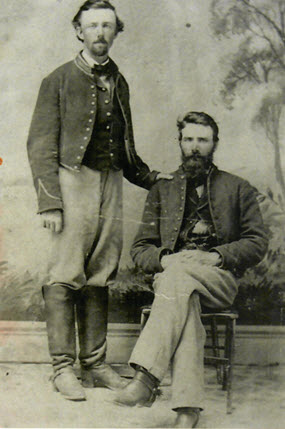
John H Lemaster. Photo courtesy of Michael Strauss.
Your ancestor may have multiple entries in Compiled Military Service Records. This could occur if a soldier served in more than one unit, or in the case of John LeMaster, if he enlisted in two different armies during the Civil War! The Civil War divided our nation, testing the loyalty of all persons who lived during this time. Lemaster chose the Confederacy, at least initially, when he enlisted with the 2nd VA Infantry in 1861 in Charlestown, VA. He fought alongside his Brigade commander, Thomas J. Jackson, who later would be known as “Stonewall Jackson.”
After the Confederate loss at the battle of Gettysburg, he deserted and lived in Martinsburg in what was now West Virginia, where on his draft registration he was listed as a deserter from the Rebel Army. In 1864, he enlisted in the United States Army with the 3rd WV Cavalry, serving out the duration of the war until 1865. After the war, he was granted a federal pension, with no mention of his former service in the Confederacy.
Here are his military service records for both the Confederate and Union armies:
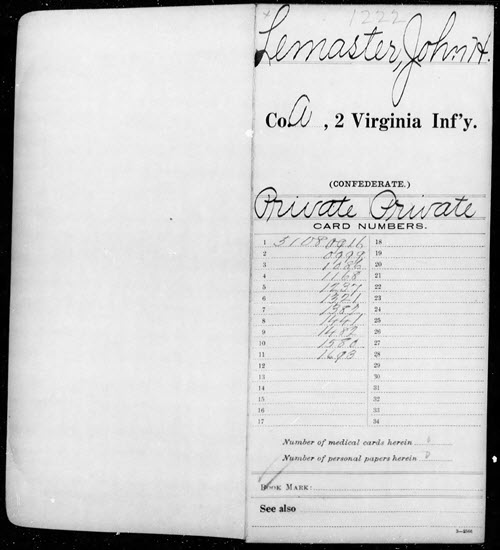
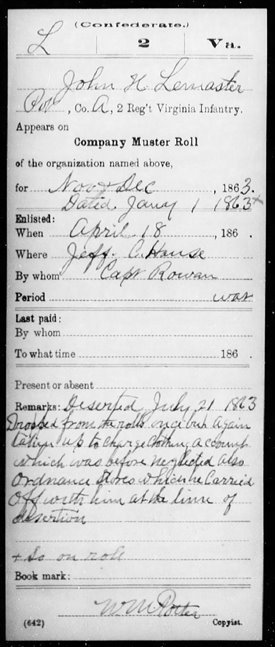
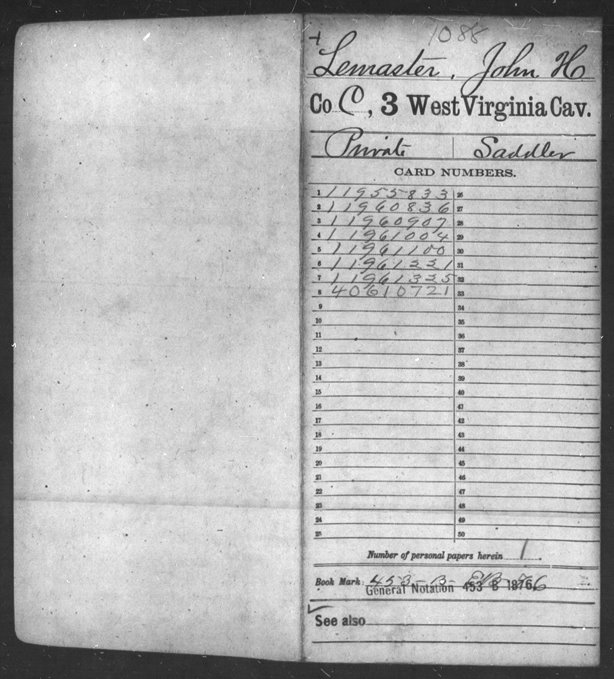
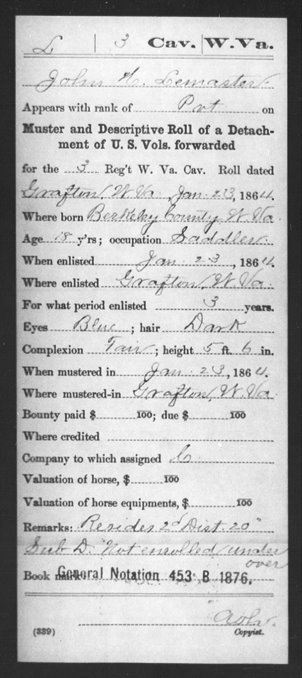
Where to Find Compiled Military Service Records
You may access various CMSR indexes and images online. Here are links to collections at subscription websites Fold3, Ancestry.com and even a couple at the free FamilySearch.org:
Compiled Military Service Records at fold3:
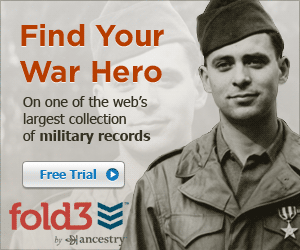 Revolutionary War. Compiled Military Service Record images for CT, DE, GA, MD, MA, NH, NJ, NY, NC, PA, RI, SC, VT, VA, and Continental Troops. Genealogists should also search the local state where their ancestors were from as some Militia isn’t included in these records. During the Revolutionary War additional Compiled Service Records were completed for the Navy, which was broken down to include Naval Personnel, Quartermaster General, and Commissary General Departments. One additional set of CMSR images covered Revolutionary War service along with Imprisonment Cards.
Revolutionary War. Compiled Military Service Record images for CT, DE, GA, MD, MA, NH, NJ, NY, NC, PA, RI, SC, VT, VA, and Continental Troops. Genealogists should also search the local state where their ancestors were from as some Militia isn’t included in these records. During the Revolutionary War additional Compiled Service Records were completed for the Navy, which was broken down to include Naval Personnel, Quartermaster General, and Commissary General Departments. One additional set of CMSR images covered Revolutionary War service along with Imprisonment Cards.- Old Wars (1784-1811). After the Revolutionary War, the newly formed United States government sought to maintain a regular Army. However, volunteer soldiers who served from 1784-1811 were recorded. (One of the reasons for volunteers to be called up would have included the Whiskey Rebellion of 1793.) Their Compiled Military Service Record full images are available here.
- War of 1812. Compiled Military Service Records Indexes for CT, DE, DC, GA, IL, IN, KY, LA, MD, MA, MI, MS, MO, NH, NJ, NY, NC, OH, PA, RI, SC, TN, VT, VA and also the Cherokee, Chickasaw, Choctaw, Creek, and Shawanoe Indians along with United States Volunteers. Full copies of CMSR are online for the Chickasaw and Creek Indians, along with the men from buy herpes medication online uk Lake Erie and Mississippi.
- Indian Wars. Compiled Military Service Records Indexes for the various Indians wars from 1815-1858.
- Mexican War. Compiled Military Service Record indexes for AL, AR, CA, FL, GA, IL, IN, IA, KY, LA, MD, DC, MA, MI, MS, MO, NJ, NY, NC, OH, PA, SC, TN, TX, VA, WI, and the Mormon Battalion and the United States Volunteers. Full copies of the CMSR are online for AR, MS, PA, TN, TX, and the Mormon Battalion.
- Civil War. Click here to search. Union: Indexes for AZ, CA, CO, CT, IL, IN, IA, KS, ME, MA, MI, MN, MO, NH, NJ, NY, OH, PA, RI, VT, WA, WI, United States Veteran Volunteers, and Veteran Reserve Corps. Full copies of CMSR for AL, AR, CA, CO, Dakota Territory, DE, DC, FL, GA, KY, LA, MD, MA, MS, MO, NE, NV, NM, NC, OR, TN, TX, UT, VT, VA, WV, United States Colored Troops, United States Volunteers, and 1st NY Engineers. Confederate: indexes are online for AL, and VA. Full copies of CMSR are online for AL, AZ, AK, FL, GA, KY, LA, MD, MO, MS, NC, SC, TN, TX, VA, Miscellaneous, Volunteers, Indians, and Officers.
- Spanish American War. Compiled Military Service Record indexes for AL, AR, CA, CO, CT, Dakota Territory, DE, DC, FL, GA, ID, IL, IN, IA, KS, KY, LA, ME, MD, MA, MI, MN, MS, MO, MT, NE, NV, NH, NJ, NY, NC, ND, OH, OK, OR, PA, PR, RI, SC, SD, TN, TX, UT, VT, VA, WA, WV, WI, WY, and United States Volunteers. Full copies of CMSR are online for FL.
Compiled Military Service Records At Ancestry.com:
 Revolutionary War. Full copies of the Compiled Military Service Records for CT, DE, GA, MD, MA, NH, NJ, NY, NC, PA, RI, SC, VT, VA, and Continental Troops. (This database often doesn’t list the local militia, as most of the men listed were part of the continental line. Researchers search by keyword or location.)
Revolutionary War. Full copies of the Compiled Military Service Records for CT, DE, GA, MD, MA, NH, NJ, NY, NC, PA, RI, SC, VT, VA, and Continental Troops. (This database often doesn’t list the local militia, as most of the men listed were part of the continental line. Researchers search by keyword or location.)- Old Wars. An index and full images of the Compiled Military Service Records of those men who served after the Revolutionary War and before the War of 1812, covering the years of 1784-1811.
- War of 1812. Abstracted lists of names, state, and military units from the Compiled Service Records (no images).
- Indian Wars: Database with images for Florida: includes the Florida Wars, Second Creek War, and the Third Seminole War from 1835-1858.
- Mexican War. Full copies of the CMSR for MS, PA, TN, TX, and the Mormon Battalion.
- Civil War: Indexes to Union Compiled Military Service Records and Confederate Compiled Military Service Records. An additional set of Service Records comes from units that were raised by the Confederate Government and not from any of the states that comprised the Confederacy; you can view the images and search by military unit.
- Spanish American War. Compiled Military Service Record Indexes cover the same geographical areas as on Fold3. Full copies of CMSR are online for Florida.
Free Compiled Military Service Records at FamilySearch.org:
FamilySearch has fewer Compiled Military Service Records that include images. One of the major collections includes the Revolutionary War CMSR’s that when searched here, the images provide a direct link to Fold3.
Most of the other major war periods are microfilmed and available at the Family History Library in Salt Lake City, Utah. With online access through both Fold3 and Ancestry provided on the computers in the library, though, accessing the film is less desirable. Click here to learn more about changes in microfilm lending at the Family History Library.

Michael Strauss contributes the Military Minutes segment on Lisa Louise Cooke’s Genealogy Gems Podcast. In the recently-published Episode 211, he profiles the 20th-century replacement for Compiled Military Service Records: the Official Military Personnel File. Click here and listen for free!
Disclosure: This article contains affiliate links and Genealogy Gems will be compensated if you make a purchase after clicking on these links (at no additional cost to you). Thank you for supporting the free Genealogy Gems podcast and blog!
by Sunny | Feb 23, 2018 | 01 What's New, Records & databases |
New North American genealogy records online this week! Featured are U.S. military, passenger and yearbook records (including WWII film footage); regional collections for New England and Great Lakes; Congressional statutes; and over 63 million Mexican genealogy records...
by Sunny | Aug 10, 2018 | 01 What's New, Records & databases |
Now online! German civil registration records for Bad Doberman, Berchtesgaden and Minden, as well as WWII UK prisoners of war records, updates to the 1939 Register, parish records for Cheshire, Cumberland and Derbyshire; British newspapers and Queensland, Australia...










